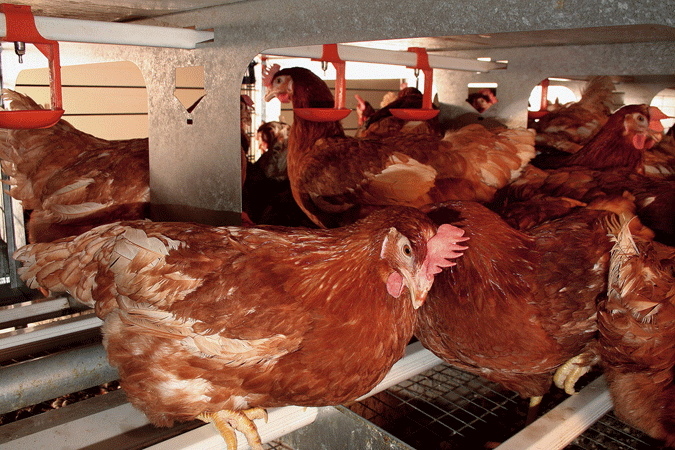Practical tips on installing and managing enriched egg cages

The EU Directive banning conventional cage egg production after 1 January 2012 leaves producers with two main choices – switch to enriched cages or opt for a non-cage system.
Enriched cages offer birds increased space, as well as areas for nesting, scratching and perching (see table, right). In some instances, it will be possible to upgrade conventional layer cages. However, many producers wishing to continue keeping caged birds will be forced to invest in a brand new housing system, to comply with the law.
The scope for upgrading from conventional battery cages to enriched cages depends largely on existing system design, according to Noble Foods’ Andrew Joret. Approved in 1999, the Directive responsible for the impending conventional cage ban stipulates a minimum height of 45cm (17.7in) at any point.
Aware of the impending new rules, manufacturers made sure that conventional battery cages installed between 1999 and 2002 met the required height standard for enriched cages. This type of system is adaptable in principle, says Mr Joret, although the cost involved may prove prohibitive.
“There is little doubt that some older producers have been planning their retirement to coincide with the changes in the law,” says Mr Joret, who is deputy chairman of the British Egg Industry Council.
“We estimate that there are about 18m cage birds in the UK, with about 15m in conventional battery cages that can’t be converted, due to the minimum height requirement. That leaves 2m bird places suitable for conversion, and some 1m already in fully enriched cages.”

Mr Joret points out that UK conventional cage egg producers are more fortunate than some of their European counterparts. In the UK, about 60% of egg production comes from caged birds, whereas in the rest of Europe the figure is closer to 80%.
He is unenthusiastic about the potential for increasing barn egg sales, which represent only a small percentage of current production. Their popularity is unlikely to grow to a significant level, because of the difficulty in communicating to the consumer how the system works, he says.
He comments that the design of enriched cage systems has improved considerably since the Directive was first issued in 1999. A clear winner in the popularity stakes so far is the 40 to 60-bird colony cage, which can offer some small financial improvements compared with conventional battery production, he says.
On average, mortality is 1% lower on enriched cage systems. The birds also consume roughly 2-3g a day less food – mainly because the enriched environment offers more stimulation, which in turn results in less wastage.
However, egg production costs are generally higher, at an average 71-72p per dozen for birds in enriched colony systems, compared with 65p per dozen for conventional cages.
Birds in enriched cages do well and appear to be more content, says Mr Joret.
However, as enriched cage systems are 10-12% more expensive than conventional battery cages, he thinks it unlikely that any producer would install enriched cages purely on economic grounds.
Flock keepers whose existing buildings are suitable for the installation of enriched cages will need to spend about £10 a bird place to comply with the impending regulations. Meanwhile, anyone starting from scratch will be facing an investment of at least £18 a bird place. To date, there are no available examples to indicate how much it would cost to bring enrichable conventional cages up to the standards required.
Most enriched systems are built around a vertically stacked set of tiered cages, six or 12 high, with catwalks every three tiers. A 60-bird colony system typically measures 3.6m (11.8ft) in length and is 1.2m (3.9ft) wide. Manufacturers recommend that the scratching area of one cage should be positioned next to the scratching area of the adjacent cage for optimal lighting.
A dimmable fluorescent lighting tube is then hung vertically between the two, providing a light every 7.2m (23.6ft) along the rows. This arrangement means the nest box areas are darker, encouraging the birds to go in and lay. The scratching areas receive the most light, which promotes natural behaviour.
A ventilated belt is the most common method of manure removal and is also a legal requirement for larger producers whose businesses need to comply with IPPC (Integrated Pollution Prevention and Control) regulations. Nest boxes are often lined with Astroturf and partitioned off with plastic curtains, or divided using a solid partition. Perches are made of durable plastic, with grooved ridges to give birds extra grip.
Egg belts need to have a shuffle mechanism, because 95% of eggs produced will be laid in the nest boxes. Unless the eggs are moved as they are laid, increased egg-to-egg contact would otherwise lead to a higher volume of seconds.
Most enriched systems will require more labour input, because there are fewer birds per building and it takes longer to move between flocks, says Mr Joret. They are also slightly more time-consuming when birds need to be moved out. Two people have to be employed to move down the rows, because one person cannot physically reach right into the wider cages.
